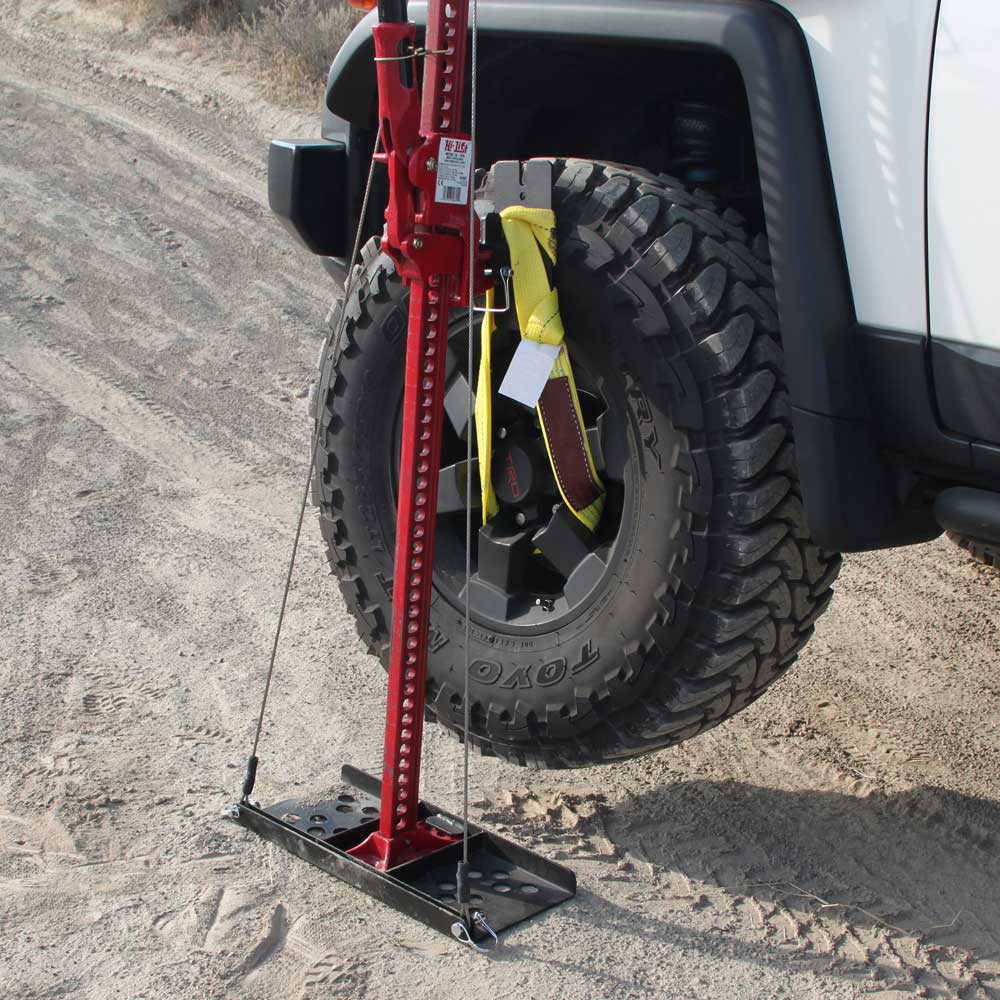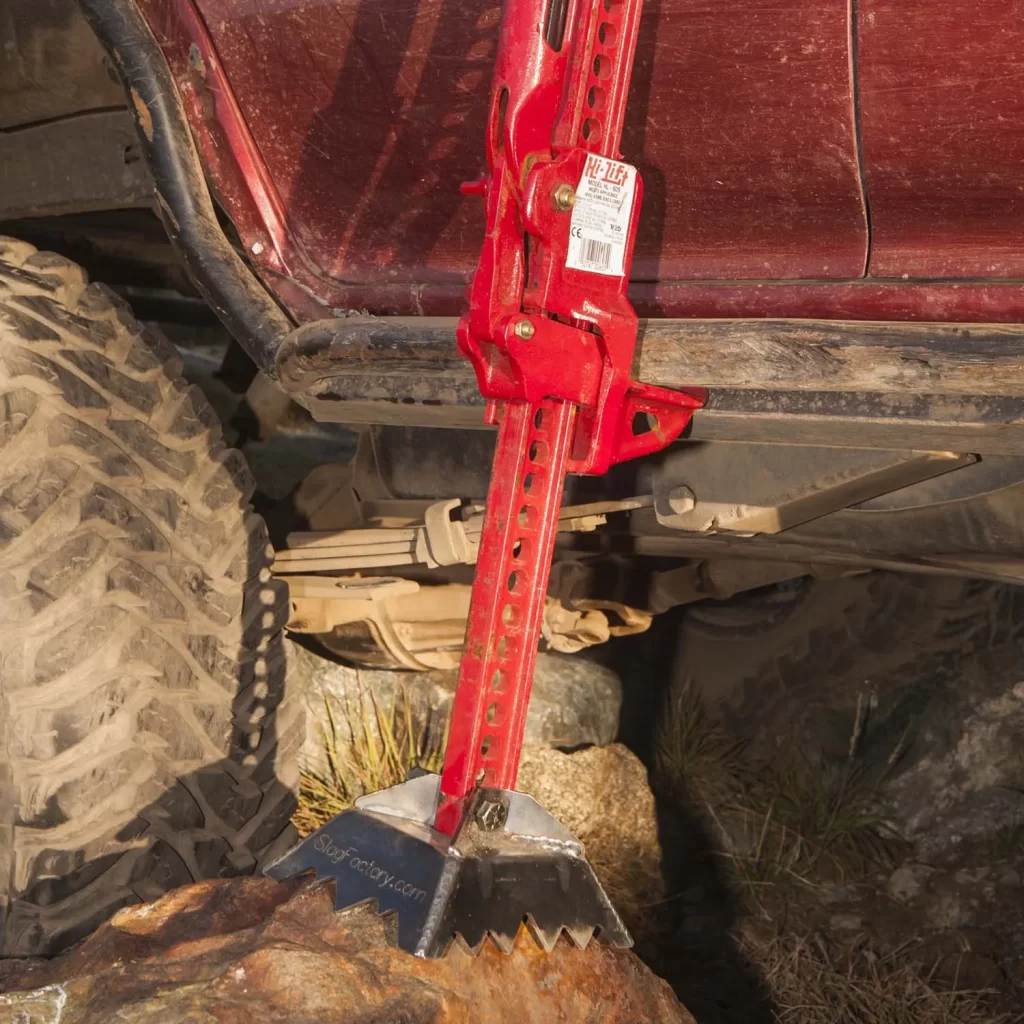When you’re miles away from pavement and stuck deep in the mud or high-centered on a rock, a solid off-road jack can mean the difference between getting home or calling for help. In wild terrain, the usual car jack just won’t cut it. You need something tough, tall, and ready to lift heavy 4x4s, trucks, or UTVs. That’s where Hi-Lift and Farm Jacks come in. These mechanical jacks are popular recovery tools among off-roaders. But even though they look similar, they’re not the same. Let’s break down the differences and see which one fits your off-road lifestyle best.
Key Takeaway:
The Hi-Lift Jack is a better long-term investment for serious off-road recovery, offering superior quality, performance, and safety. A Farm Jack can work in milder situations, but lacks the consistency and reliability that seasoned off-roaders count on. Choose based on your terrain, budget, and how often you hit the trail.
What Is a Hi-Lift Jack?

The Hi-Lift Jack is basically the gold standard in off-road jacks. It’s a tall, mechanical lifting tool made mostly of cast or stamped steel. It uses a ratcheting system with climbing pins that let you lift a vehicle from the bumpers, sliders, or special jack points. Hi-Lift is actually a brand name that’s become so well-known, people often use it to describe any jack of this kind.
Hi-Lifts are known for being extremely rugged. They’re used not just for lifting, but also for winching, clamping, spreading, and even breaking a bead on a tire. A standard Hi-Lift can lift up to 4,660 pounds and reach up to 60 inches tall—plenty for lifted rigs and oversized tires.
What Is a Farm Jack?

The Farm Jack, sometimes called a handyman jack or utility jack, looks a lot like the Hi-Lift. In fact, it works the same way—with a tall I-beam frame and ratcheting lifting mechanism. But it’s more of a generic version. Farm Jacks were originally made for lifting tractors, stretching fencing, or pulling out fence posts.
While they can still be used for off-road recoveries, their quality depends on the manufacturer. Some are made with cheaper metals or have looser tolerances in the pins and climbing mechanism. This means they might not hold up under heavy loads or in rough conditions as well as a true Hi-Lift.
Hi-Lift vs Farm Jack: Key Differences Explained
When it comes to off-road recovery, not all jacks are created equal. At a glance, Hi-Lift and Farm Jacks may seem similar—they’re tall, mechanical, and use a ratcheting system to lift vehicles. But the differences in quality, performance, and safety can be huge once you hit the trail. Here’s a deeper look at how they really stack up.
Build Quality
Hi-Lift Jacks are built like tanks. They’re made in the USA using high-tensile steel, and each part—base, handle, climbing pins—is precision-engineered to hold up under extreme stress. The beams are thick and coated to resist rust and corrosion. Some Hi-Lift models even feature cast iron components at load-bearing points, which increases strength and longevity.
Farm Jacks, on the other hand, vary widely. Many are manufactured overseas with fewer quality control checks. Materials may include thinner steel or low-grade alloys. The I-beam might flex under heavy load. Over time, with enough use, some Farm Jacks develop loose pins or warped frames. If you’re depending on your jack during a solo recovery in deep terrain, that kind of inconsistency can turn dangerous fast.
Brand Reputation
Hi-Lift is the Kleenex of off-road jacks—people often call all jacks of this kind “Hi-Lifts” even if they’re not. The company started in 1905 and has built a century of trust in off-roading, farming, and search-and-rescue communities. When you buy a Hi-Lift, you’re getting a product that’s been tested in swamps, deserts, snow, and rocky terrain by thousands of pros and enthusiasts.
Farm Jacks don’t come with that legacy. They’re generic and often sold under dozens of names with no centralized brand reputation. That means customer support is often non-existent, and warranties (if any) are limited. The lack of brand accountability increases the risk of product failure, especially under real-world off-road conditions.
Price Tag
Farm Jacks are tempting because of their low price. You can grab one for as little as $40–60, which looks like a deal compared to a Hi-Lift, which often runs $90–150 depending on the size and accessories.
But here’s the catch—what you save in price, you might lose in durability, safety, and performance. A cheap jack might break or seize after a few recoveries, especially if exposed to dirt, moisture, or high torque. A Hi-Lift may cost more upfront, but it will last for decades with basic maintenance. In off-roading, reliability is priceless.
Safety Features
Hi-Lift doesn’t just lift—it protects. It includes safety-oriented components like:
- Zinc-plated climbing pins for smoother operation
- Locking handles that prevent sudden movement
- Base plates to stabilize on sand, snow, or mud
- Optional accessories like Lift-Mate straps and winch kits
These features reduce the risk of the jack slipping, the handle kicking back violently, or the base sinking into soft terrain.
Farm Jacks often skip these add-ons. Many have basic steel pins that wear out quickly, and their handle locking mechanisms (if present at all) may be crude. Without a stabilizer or reliable pin system, you’re more likely to experience jack failures or accidents—especially on uneven ground.
Precision & Mechanism Tolerance
One of the most overlooked but critical differences is mechanical precision. Hi-Lift Jacks are engineered with tight tolerances between their moving parts—especially in the climbing pins and lifting mechanism. This results in smoother lifts with less wobble or jerky movement.
Farm Jacks often have looser tolerances. The pins might not seat as snugly, and the lifting motion can feel choppy or unpredictable. When lifting a 3-ton vehicle on unstable ground, a sudden jerk or missed pin can make the whole setup dangerously unstable.
Also, Hi-Lifts undergo rigorous quality control, which means each jack performs consistently. Farm Jacks can vary even within the same batch.
Performance in Off-Road Conditions
Off-roading is never predictable. One minute you’re cruising along a rocky trail, and the next, your rig is buried in wet clay or nose-down in a washout. In those moments, your jack is more than just a tool—it’s a lifeline. So how do Hi-Lift and Farm Jacks really perform when the terrain turns wild?
Handling Uneven Terrain
Hi-Lift Jacks are built with off-road conditions in mind. Their long I-beam allows you to reach lifted frames or bumpers, even if the ground is uneven. More importantly, the climbing mechanism is engineered to stay stable under shifting loads. If the surface underneath shifts a little—like a rock rolling or soft dirt compressing—the jack still keeps its grip and balance as long as it’s used properly.
Pairing a Hi-Lift with accessories like a Jack Base Plate or a sand plate is essential. These wide stabilizers help prevent the jack from sinking into soft terrain like snow, sand, or mud. Some even have teeth or spikes that bite into the ground for extra grip.
Farm Jacks, by contrast, often struggle in these same conditions. Because many are built with less precision and cheaper materials, they’re more prone to instability when the ground shifts. And without a reliable base plate—or if you’re using a narrow foot on unstable ground—they can wobble, sink, or worse, kick out under load.
Performance on Mud, Snow, and Sand
Hi-Lift Jacks are proven in low-traction environments. In deep mud, they can lift the vehicle high enough to place traction boards or rocks under the tires. In snowy conditions, a Hi-Lift’s long reach helps overcome the challenge of lifting from buried or iced-over jack points.
Sand presents a unique challenge—fine particles shift easily, causing jacks to sink quickly. This is where Hi-Lift’s optional off-road base makes a real difference. It distributes weight over a wider area, preventing sudden tipping. Some even come with lanyards to keep the base centered during the lift.
Farm Jacks may not handle this as well. Their narrower feet sink faster, and their lack of accessories means they’re often unstable in these soft environments. If they do tip or lean, the ratcheting mechanism may seize up—leaving you stuck mid-lift.
Dealing With Weight Shift and Load Stability

When lifting a heavy off-road vehicle, the force of gravity combined with an uneven load can be dangerous. A sudden slip in the soil or a shift in the jack’s contact point can cause thousands of pounds to lurch. This is where the quality of the jack’s internal components becomes critical.
Hi-Lift’s cast steel or cast iron parts don’t flex under high stress. The climbing pins engage cleanly with every lift, and the handle’s travel is consistent. That stability matters when you’re halfway through a lift and the rear axle starts to swing.
Farm Jacks don’t always deliver the same consistency. Their climbing pins might not seat correctly, or the beam may flex slightly. Under strain, even a small mechanical failure can create a domino effect—jerking the vehicle sideways or causing the jack to buckle.
Real-World Recovery Examples
Imagine trying to lift a fully loaded Toyota Land Cruiser that’s bottomed out on a rocky incline. With a Hi-Lift, you can use a Lift-Mate to hook directly to the wheel, raising the tire high enough to build traction underneath. The Hi-Lift’s precise mechanism lets you inch the vehicle upward, even in tricky spots.
Now, picture using a Farm Jack in that same situation. Without a wheel hook or stabilizer, you’ll struggle to get a solid lift. And if that jack shifts one inch the wrong way, you’re risking damage—or worse, injury.
Summary of Off-Road Performance
| Feature | Hi-Lift Jack | Farm Jack |
| Terrain Compatibility | Excellent in mud, sand, snow, rocks | Fair in dry, flat terrain |
| Stability on Uneven Surfaces | High (with base plate or stabilizer) | Low to moderate (no standard base support) |
| Risk of Jack Slipping | Low (tight tolerances, add-on support) | High (depends on manufacturer & usage) |
| Off-Road Accessories Available | Many (lift-mate, base, winch kit) | Few to none |
| Recovery Use in Harsh Terrain | Highly recommended | Not ideal for critical recovery situations |
Safety Considerations
Off-road jacks—especially tall, mechanical ones like Hi-Lift and Farm Jacks—are incredibly strong tools. But with great power comes real danger. These jacks can lift over two tons of vehicle weight high off the ground, and if you’re not careful, they can slip, fall, or even launch their handles with bone-breaking force. That’s why safety isn’t just a best practice—it’s non-negotiable.
Understanding the Danger Zone
Most accidents happen because users underestimate how unstable these jacks can be—especially when used on uneven, muddy, or rocky ground. The narrow base, combined with high lifting height creates a tall, skinny tower that’s easy to tip. If the load shifts even slightly or the jack isn’t perfectly upright, it can fall sideways instantly.
The jack handle is another risk. When lowering a load, the handle is under extreme tension. If it slips from your hand or pops out of position, it can snap up violently, hitting you in the face, chest, or arms. This is called handle kickback, and it’s one of the most common causes of jack-related injuries.
Personal Protection is Essential
Before you even touch the jack, make sure you’re wearing:
- Heavy-duty gloves to protect from pinch points and metal burrs
- Boots with strong soles for stability on loose ground
- Eye protection if there’s a risk of flying debris or jack rebound
Gloves are especially critical when lowering the handle. They give you a better grip and keep your skin safe from sudden movements or slips.
Never Trust a Jack Alone
This is a golden rule: Never crawl under a vehicle supported only by a Hi-Lift or Farm Jack. These tools are for lifting, not holding. They’re too unstable to be relied on as a support device.
If you need to work under the vehicle, you must:
- Place wheel chocks behind the tires to prevent rolling
- Use jack stands or wood cribbing blocks to support the vehicle securely
- Lower the jack until the load rests firmly on the secondary support
Hi-Lift warns against using their jacks as primary supports. A sudden mechanical failure, slipping base, or strong wind can drop the vehicle instantly.
Ground Surface Matters More Than You Think
Even the best jack is useless if it’s not standing on solid ground.
- Soft soil, sand, or mud? Use a jack base plate. These are wide pads that sit under the foot of the jack to spread out the load. Without one, the jack can quickly sink, lean, or topple.
- Rocky or sloped terrain? Find the flattest area possible. Dig a small level patch if needed. Use rocks, wood, or traction boards under the base to create a stable surface.
- On trails? Always carry a base plate in your recovery kit. Some models even have spikes or gripping teeth to bite into earth or ice.
Inspect Before and After Every Use
Every time you use your jack, inspect it like your life depends on it—because it does.
Look for:
- Bent or rusted beams
- Worn climbing pins or springs
- Loose bolts or warped handle mechanisms
- Mud or grit in the ratcheting channel
A poorly maintained jack can seize up during a lift or fail under load. Clean it after each use, especially if you’ve been in sand, snow, or wet conditions. Use a dry lube on the climbing pins to keep them moving smoothly.
Optional but Highly Recommended Safety Add-ons
- Handle isolator strap or clamp – Prevents accidental release or movement during transport or use.
- Lift-Mate or wheel lift adapter – Lets you lift from the wheel instead of the bumper or rock sliders, keeping the center of gravity lower.
- Recovery damper – If using the jack as a winch, a damper reduces recoil if the chain or strap snaps.
- Trail-rated base plate – Specifically designed to work on soft or uneven terrain with added traction grip.
These tools reduce risk and make recovery safer and smoother.
Quick Safety Checklist
✅ Wear gloves and boots
✅ Never crawl under a vehicle supported only by the jack
✅ Always use a jack based on soft ground
✅ Check climbing pins and mechanism before lifting
✅ Lower the vehicle onto jack stands or cribbing
✅ Keep body parts away from the jack handle path
✅ Carry wheel chocks and a stabilizer plate in your gear bag
Which One Should You Choose? (Decision Guide)
- Choose a Hi-Lift if… You go off-road often, drive a lifted 4×4, care about build quality, or want a reliable tool that does more than just lifting. It’s the go-to jack for serious overlanders and off-road pros.
- Choose a Farm Jack if… you’re on a tight budget, need a backup jack, or only do light-duty lifting like pulling fence posts or lifting small trailers.
If you’re a weekend trail rider with a Jeep or Tacoma, go Hi-Lift. If you’re on a farm and occasionally pull a UTV from a ditch, a well-made Farm Jack might do the trick.
Real-World User Reviews and Field Feedback
Many off-roaders report that while Farm Jacks can work, they’ve experienced more wear and tear and even breakage compared to Hi-Lift. Forum users often share photos of bent handles, failed pins, or slipping mechanisms from budget jacks.
In contrast, Hi-Lift Jack owners praise their long-term durability—even after years of abuse on rough trails. The aftermarket accessories, including lift-mate straps and recovery kits, also add serious value.
Complementary Gear for Hi-Lift and Farm Jacks
If you’re buying one of these jacks, you’ll also want:
- Jack base/stabilizer plate – keeps the jack from sinking
- Lift-mate strap – lets you lift from wheels or axles
- Jack mount – secures your jack on roof racks or bumpers
- Gloves and traction boards – for a safer, cleaner recovery
- Snatch strap or winch – in case lifting isn’t enough
These tools work together to make recovery safer and faster.
Conclusion: Choosing the Right Off-Road Jack
Off-road jacks are more than just tools—they’re your lifeline when things go sideways. The Hi-Lift Jack is hands-down the better choice if you’re serious about off-roading. It’s built to last, safer, and backed by a legacy. But if you’re doing light lifting and want to save some cash, a Farm Jack can still get the job done—just be cautious and inspect it often.
Either way, know your jack, train with it, and keep it maintained. The trail doesn’t forgive mistakes.

